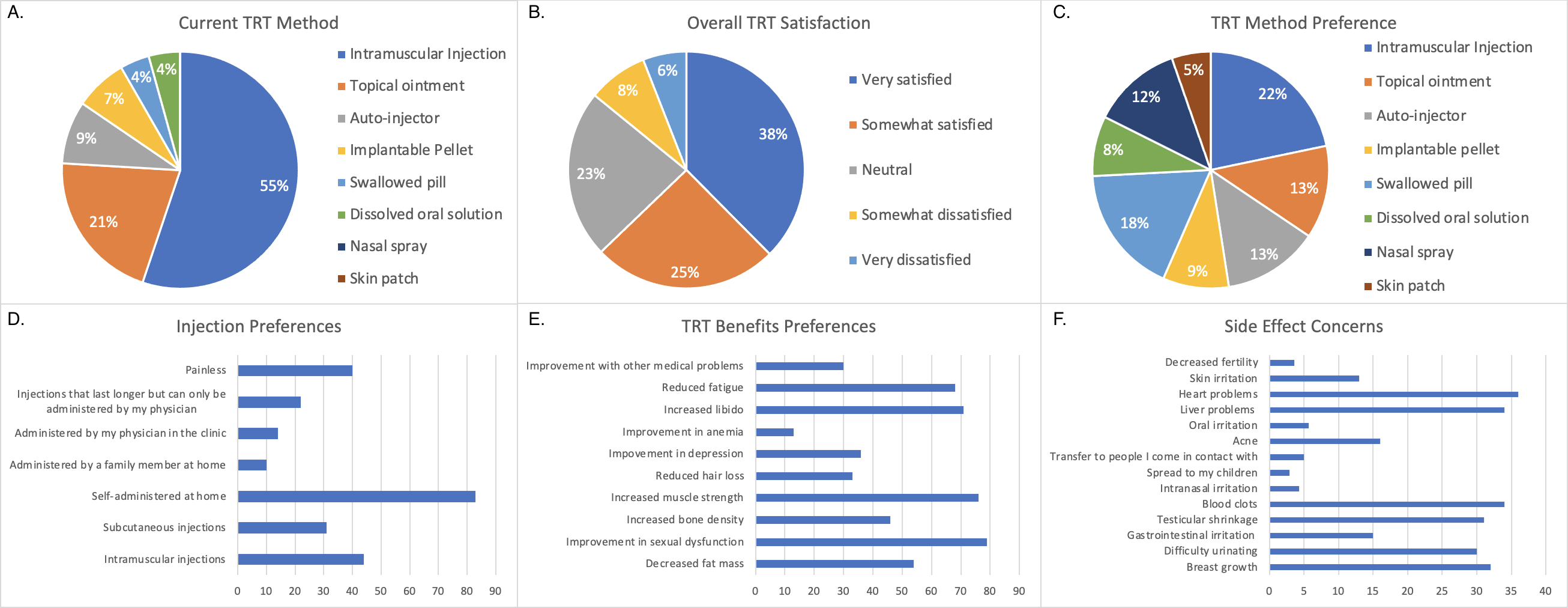Back
Poster, Podium & Video Sessions
Moderated Poster
MP35: Sexual Function/Dysfunction: Medical, Hormonal & Non-surgical Therapy I
MP35-04: Testosterone Replacement Therapy: Patient Reported Preferences
Saturday, May 14, 2022
4:30 PM – 5:45 PM
Location: Room 222
Charles Loeb*, Jake Miller, Douglas Schneider, Faysal Yafi, Orange, CA

Charles A. Loeb, MD
Urology Resident
UC Irvine
Poster Presenter(s)
Introduction: Men with symptomatic hypogonadism can be treated with testosterone replacement therapy (TRT) in a variety of methods. Multiple factors including cost, efficacy, adverse effects, and mechanism and frequency of administration must be considered when prescribing to promote maximum patient satisfaction and clinical results. We aim to determine the attitudes, opinions and preferences of men regarding their TRT and the factors that influence these preferences.
Methods: An anonymous online survey was distributed to 783 men currently on TRT in a single men’s health clinic. Men answered questions on demographics, comorbidities, social history and validated questionnaires Sexual Health Inventory for Men (SHIM) and Androgen Deficiency in the Aging Male (ADAM). They were asked about prior and current methods and overall satisfaction with current TRT. Preferences regarding administration, cost, effectiveness and adverse effects were assessed qualitatively and in head-to-head comparisons.
Results: The median age of 140 respondents was 65 years (32-87). The most commonly reported method of administration was intramuscular injection (A). Overall satisfaction with current therapy was reported as very or somewhat satisfied in the majority of respondents (B). The most commonly preferred methods of administration were intramuscular injection (22%), swallowed pill (18%), subcutaneous auto-injector (13%), topical ointment (13%), nasal spray (12%), dissolved oral solution (8%) and skin patch (5%) (C). The most commonly preferred injection method was self-administration at home (D). The most preferred potential benefit was improved sexual function (E). The most concerning potential side effects were cardiac related (F). Higher satisfaction was associated with use of injection (OR 7.21, p=0.011), pellet (12.58, p=0.011), autoinjector (13.50, p=0.006), and sexually active patients (3.30, p=0.002). Lower satisfaction was associated with older age (OR 0.94, p=0.012) and positive ADAM score (0.04, p=0.003).
Conclusions: The majority of respondents were satisfied overall with their current therapy. The preferred TRT option was self-injection therapy at home. Treatment efficacy and fewest side effects were the most important considerations for patients on TRT.
Source of Funding: None

Methods: An anonymous online survey was distributed to 783 men currently on TRT in a single men’s health clinic. Men answered questions on demographics, comorbidities, social history and validated questionnaires Sexual Health Inventory for Men (SHIM) and Androgen Deficiency in the Aging Male (ADAM). They were asked about prior and current methods and overall satisfaction with current TRT. Preferences regarding administration, cost, effectiveness and adverse effects were assessed qualitatively and in head-to-head comparisons.
Results: The median age of 140 respondents was 65 years (32-87). The most commonly reported method of administration was intramuscular injection (A). Overall satisfaction with current therapy was reported as very or somewhat satisfied in the majority of respondents (B). The most commonly preferred methods of administration were intramuscular injection (22%), swallowed pill (18%), subcutaneous auto-injector (13%), topical ointment (13%), nasal spray (12%), dissolved oral solution (8%) and skin patch (5%) (C). The most commonly preferred injection method was self-administration at home (D). The most preferred potential benefit was improved sexual function (E). The most concerning potential side effects were cardiac related (F). Higher satisfaction was associated with use of injection (OR 7.21, p=0.011), pellet (12.58, p=0.011), autoinjector (13.50, p=0.006), and sexually active patients (3.30, p=0.002). Lower satisfaction was associated with older age (OR 0.94, p=0.012) and positive ADAM score (0.04, p=0.003).
Conclusions: The majority of respondents were satisfied overall with their current therapy. The preferred TRT option was self-injection therapy at home. Treatment efficacy and fewest side effects were the most important considerations for patients on TRT.
Source of Funding: None


.jpg)
.jpg)